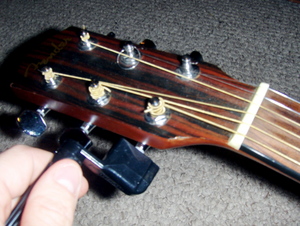Playing the Banjo is a very rewarding. The Banjo has a rich American and African history and is actually a very versatile instrument. Even though the Banjo is usually associated with Bluegrass music, it can be used to play Jazz, Ragtime, Rock, Blues and many other styles.
For this discussion I will use a standard five string banjo as an example. The five string banjo is designed having a fifth string that has a tuning peg starting on the fifth fret of the neck, along with four normal length banjo strings.
A popular tuning in banjo playing is the D tuning. This tuning may also be referred to as the “Rubin” tuning, named so because Earl Scruggs used this tuning on the song Rubin. The banjo is tuned to an open D chord. The strings of a banjo are tuned to have the notes of D (root), F# (third), and A (fifth).
The strings are tuned as follows highest to lowest:
1st string – D
2nd string – A
3rd string – F#
4th string – D
5th string – F# (may also be tuned to A)
When tuning the banjo, I generally start on the 4th string. This is the lowest (thickest) full length string on the instrument. This string is tuned to open D note. If you do not have an electric tuner, there are many internet sites that will provide a tone to aid in tuning.
After the 4th string is tuned to open D, Place your finger on the forth fret, 4th string. This is F#, which will equal the 3rd string when played open. Adjust the 3rd string appropriately to match the tones.
After the 3rd string is tuned to open F#, place your finger on the third fret, 3rd string. This is A, which is equal to the 2nd string when played open. Adjust the 2nd string appropriately to match the tones.
Next is to tune the first string. After the 2nd string is tuned to A, place your finger on the fifth fret, 2nd string. This is D, which is equal to the first string when played open. Adjust the 1st string appropriately to match these tones.
Now it is time to tune the 5th string, which is the high G string with the tuning peg located on the fifth fret of the neck board. Place your finger on the forth fret 1st string. This is the F# note that is equal to the fifth string when played open. There are songs that may have the fifth string tuned up to A (if you want to tune to A, then place your finger on the first string, seventh fret. This is the A note). This is possible and still fits with a ‘normal’ D tuning. Be careful when adjusting the fifth string, especially when tuning up to A, it is very easy to break!
Lastly fine tune all of the strings when you are done. You have changed the surface tension of the banjo head as you tuned every string; therefore, they will need adjusting.



